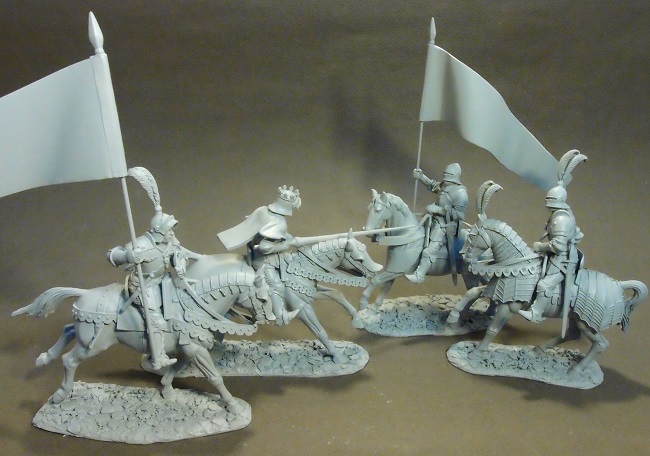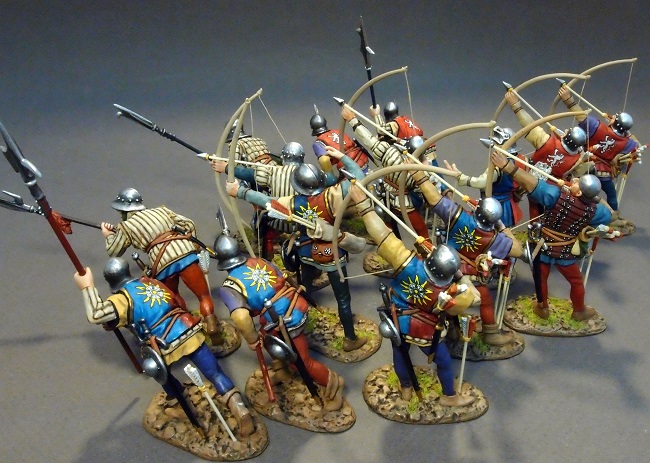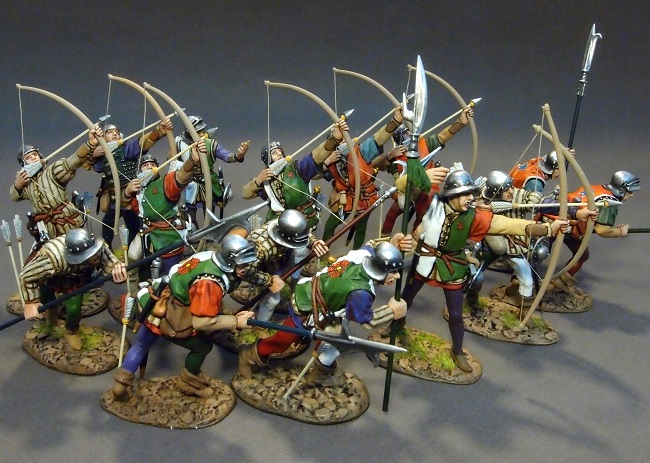|



Tedtoy


  

 




 












 









 







First Legion

 

 








 
Collectors
Showcase


 





  
   


 

Black Hawk


















   






Hudson & Allen
General


  |
The War of the Roses

|
The Wars of the Roses were a series of dynastic wars for the
throne of England. They were fought between supporters of two
rival branches of the royal House of Plantagenet, the houses of
Lancaster and York. They were fought in several sporadic
episodes between 1455 and 1487, although there was related
fighting before and after this period. The conflict resulted
from social and financial troubles that followed the Hundred
Years' War, combined with the mental infirmity and weak rule of
Henry VI, which revived interest in the alternative claim to the
throne of Richard, Duke of York.
The final victory went to a claimant of the Lancastrian
party, Henry Tudor, who defeated the last Yorkist king, Richard
III, at the Battle of Bosworth Field. After assuming the throne
as Henry VII, Henry Tudor married Elizabeth of York, the eldest
daughter and heiress of Edward IV, thereby uniting the two
claims. The House of Tudor ruled England and Wales until 1603
The Battle of Bosworth Field
The Battle of Bosworth
(or Bosworth Field) was the last significant battle of the Wars
of the Roses, the civil war between the Houses of Lancaster and
York that raged across England in the latter half of the 15th
century. Fought on 22 August 1485, the battle was won by the
Lancastrians. Their leader Henry Tudor, Earl of Richmond, by his
victory became the first English monarch of the Tudor dynasty.
His opponent, Richard III, the last king of the House of York,
was killed in the battle. Historians consider Bosworth Field to
mark the end of the Plantagenet dynasty, making it a defining
moment of English and Welsh history. |
|
The Yorkist Army

The Royalist Army was led by King Richard III. Richard's
most loyal subject was John Howard, 1st Duke of Norfolk. The
duke had served Richard's brother for many years and was one of
Edward IV's closer confidantes, he was a military veteran,
having fought in the Battle of Towton in 1461 and served as
Hastings' deputy at Calais in 1471. Richard formed his
army into three divisions or ‘battles”, The Vanguard or main
“battle” was under the command of the Duke of Norfolk, the main
body was led by Richard, and the rearguard under the command of
the Earl of Northumberland |
|
Item # |
Description |
Price |

YORK34 |
Yorkist Archer,
JUST RELEASED |
$42.00
 |

YORK31 |
Yorkist Archer, JUST RELEASED |
$42.00
 |

YORK30 |
Yorkist Archer |
$42.00
 |

YORK30N |
Yorkist Archers, out of stock |
$110.00
 |

YORK27 |
Yorkist Billmen |
$80.00
 |

YORK27N |
Yorkist Billmen, out of stock |
$150.00
 |
|
By
the time of the Wars Of The Roses, badges were of considerable
importance. These along with the Livery Colours were closely
associated with what was then known as Livery and Retaining
(Bastard Feudalism). The badges were rarely worn by their
owners, for they were marks of ownership. They were, however,
worn by his servants, house-hold men, retainers, and probably
temporarily by the adherents to his cause.
So great and extensive was the use of these badges,
that they were far more generally employed than the coat of
arms. For where a man’s badge would be common knowledge and bear
some repute throughout the kingdom, few people would know what
his coat of arms looked like.
The Retinue of King Richard III |
|
Item # |
Description |
Price |

RYORK09 |
Retinue of King Richard III, Yorkist
Billmen |
$82.00
 |

RYORK09N |
Retinue of King Richard III, Yorkist Billmen |
$154.00
 |


RYORK15 |
Retinue of King Richard III, Yorkist
Archers, JUST
RELEASED |
$82.00
 |
|
Richard's most loyal subject was John
Howard, 1st Duke of Norfolk. The duke had served
Richard's brother for many years and was one of Edward IV's
closer confidantes, he was a military veteran, having fought in
the Battle of Towton in 1461 and served
as Hastings' deputy at Calais in 1471.
The Retinue of John Howard, 1st Duke of
Norfolk |
|
Item # |
Description |
Price |

NFYORK09 |
Retinue of Duke of Norfolk, Yorkist
Billmen |
$82.00
 |

NFYORK09N |
Retinue of Duke of Norfolk, Yorkist Billmen |
$154.00
 |


NFYORK15 |
Retinue of Duke of Norfolk, Yorkist
Archers, JUST
RELEASED |
$82.00
 |
|
The Lancastrian Army

Having not fought in
any battles, Henry Tudor was not regarded as much of a warrior.
Chroniclers of the period found him more interested in commerce
and finance. Having spent the first fourteen years of his life
in Wales and the next fourteen in Brittany and France, Henry
Tudor was therefore unfamiliar with the arts of war and a
stranger to the land he was trying to conquer. But he was known
as being strong and decisive. Henry recruited several
experienced veterans on whom he could rely for military advice
and the command of his armies, most notably John de Vere, 13th
Earl of Oxford, who was Henry's principal military commander.
Henry Tudor decided to commit most of his small force into one
single large division or “battle” and place it under the command
of the Earl of Oxford |
|
Item # |
Description |
Price |

LANC34 |
Lancastrian Archer,
JUST RELEASED |
$42.00
 |

LANC31 |
Lancastrian Archer, JUST RELEASED |
$42.00
 |

LANC30 |
Lancastrian Archer |
$42.00
 |

LANC30N |
Lancastrian Archers,
out of stock |
$110.00
 |

LANC27 |
Lancastrian Billmen |
$80.00
 |

LANC27N |
Lancastrian Billmen,
out of stock |
$150.00
 |
|
By
the time of the Wars Of The Roses, badges were of considerable
importance. These along with the Livery Colours were closely
associated with what was then known as Livery and Retaining
(Bastard Feudalism). The badges were rarely worn by their
owners, for they were marks of ownership. They were, however,
worn by his servants, house-hold men, retainers, and probably
temporarily by the adherents to his cause.
So great and extensive was the use of these badges,
that they were far more generally employed than the coat of
arms. For where a man’s badge would be common knowledge and bear
some repute throughout the kingdom, few people would know what
his coat of arms looked like.
The Retinue of Henry Tudor |
|
Item # |
Description |
Price |

HLANC09 |
Retinue of Henry Tudor,
Lancastrian Billmen |
$82.00
 |

HLANC09N |
Retinue of Henry Tudor, Lancastrian Billmen |
$154.00
 |


HLANC15 |
Retinue of Henry Tudor,
Lancastrian Archers, JUST RELEASED |
$82.00
 |
|
Henry recruited several
experienced veterans on whom he could rely for military advice
and the command of his armies, most notably John de Vere,
13th Earl of Oxford, who was Henry's principal
military commander. Henry Tudor decided to commit
most of his small force into one single large division or
“battle” and place it under the command of the Earl of Oxford.
The Retinue of John de Vere, 13th Earl of
Oxford |
|
Item # |
Description |
Price |

OXLANC09 |
Retinue of John de Vere,
Lancastrian Billmen |
$82.00
 |

OXLANC09N |
Retinue of John de Vere, Lancastrian Billmen |
$154.00
 |

_small.JPG)
OXLANC15 |
Retinue of John de Vere,
Lancastrian Archers, JUST RELEASED |
$82.00
 |

107 W. 3rd St.
Owensboro, KY 42301
270-929-2876
All web site content
©2005-16 Tedtoy Miniatures
|



